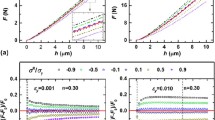Abstract
A spherical indentation-based method and its numerical verification, which is capable of identifying the plastic properties, have been respectively provided by our previous work [P. Jiang, et al., J. Mater. Res.24, 1045 (2009)] and [T. Zhang, et al., J. Mater. Res.24, 3653 (2009)]. To examine its effectiveness for practical application, 10 typical metals were selected to perform experimental verifications. Here, the above method was used in combination with the Oliver–Pharr model to avoid its dependence on the previously known elastic modulus. To obtain reliable results, a reasonable calibration has been performed for the used spherical tip with imperfect shape. Finally, the present verification has shown that the deviations of yield strength and elastic modulus obtained from the indentation tests are at most 40% but are generally within 25%. And the effect of the difference in constitutive relationships between the ideal model and the actual material on the accuracy of the indentation-based method has also been illustrated.









Similar content being viewed by others
REFERENCES
D. Tabor: Hardness of Metals (Clarendon Press, Oxford, UK, 1951), pp. 73, 76.
M. Dao and N. Chollacoop: Computational modeling of the forward and reverse problems in instrumented sharp indentation. Acta Mater. 49, 3899 (2001).
Y.T. Cheng and C.M. Cheng: Can stress-strain relationships be obtained from indentation curves using conical and pyramidal indenters? J. Mater. Res. 14(9), 3493 (1999).
X. Chen, N. Ogasawara, M.H. Zhao, and N. Chiba: On the uniqueness of measuring elastoplastic properties from indentation: The indistinguishable mystical materials. J. Mech. Phys. Solids 55(8), 1618 (2007).
Y.P. Cao and J. Lu: An energy-based method to extract plastic properties of metal materials from conical indentation tests. J. Mater. Res. 20(5), 1194 (2005).
J.H. Ahn and D. Kwon: Derivation of plastic stress-strain relationship from ball indentation: Examination of strain definition and pileup effect. J. Mater. Res. 16, 3170 (2001).
N. Choppacoop, M. Dao, and S. Suresh: Depth-sensing instrumented indentation with dual sharp indenters. Acta Mater. 51, 3713 (2003).
J.Y. Kim and K.W. Lee: Determination of tensile properties by instrumented indentation technique: Representative stress and strain approach. Surf. Coat. Tech. 201, 4278 (2006).
S. Jayaraman, G.T. Hahn, W.C. Oliver, C.A. Rubin, and P.C. Bastias: Determination of monotonic stress strain curve of hard materials from ultra-low-load indentation tests. Int. J. Solids Struct. 35, 365 (1998).
B. Taljat, T. Zacharia, and F. Kosel: New analytical procedure to determine stress-strain curve from spherical indentation data. Int. J. Solids Struct. 35(33), 4411 (1998).
J.S. Field and M.V. Swain: Determining the mechanical properties of small volumes of material from submicron spherical indentations. J. Mater. Res. 10(1), 101 (1995).
Y.P. Cao and J. Lu: A new method to extract the plastic properties of metal materials from an instrumented spherical indentation loading curve. Acta Mater. 52, 4023 (2004).
M.H. Zhao, N. Ogasawara, N. Chiba, and X. Chen: A new approach to measure the elastic–plastic properties of bulk materials using spherical indentation. Acta Mater. 54, 23 (2006).
P. Jiang, T.H. Zhang, Y.H. Feng, and N.G. Liang: Determination of plastic properties by instrumented spherical indentation: Expanding cavity model and similarity solution approach. J. Mater. Res. 24(3), 1045 (2009).
T.H. Zhang, P. Jiang, Y.H. Feng, and R. Yang: Numerical verification for instrumented spherical indentation techniques in determining the plastic properties of materials. J. Mater. Res. 24(12), 3653 (2009).
W.C. Oliver and G.M. Pharr: An improved technique for determining hardness and elastic modulus using load and displacement sensing indentation experiments. J. Mater. Res. 7(6), 1546 (1992).
L. Liu, N. Ogasawara, N. Chiba, and X. Chen: Can indentation technique measure unique elastoplastic properties? J. Mater. Res. 24(3), 784 (2009).
R. Hill, B. Storakers, and A.B. Zdunek: A theoretical study of the Brinell hardness test. Proc. R. Soc. London, Ser. A 423, 301 (1989).
ISO 4288:1996. Geometrical product specifications (GPS)—Surface texture: Profile method—Rules and procedures for the assessment of surface texture.
ISO 14577:2002. Metallic materials—Instrumented indentation test for hardness and materials parameters.
Acknowledgment
We acknowledge the support of the National Natural Science Foundation of China (Grant Nos. 11025212 and 10872200).
Author information
Authors and Affiliations
Corresponding author
Rights and permissions
About this article
Cite this article
Jiang, P., Zhang, T. & Yang, R. Experimental verification for an instrumented spherical indentation technique in determining mechanical properties of metallic materials. Journal of Materials Research 26, 1414–1420 (2011). https://doi.org/10.1557/jmr.2011.51
Received:
Accepted:
Published:
Issue Date:
DOI: https://doi.org/10.1557/jmr.2011.51




